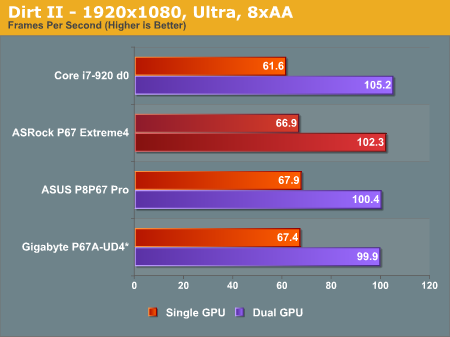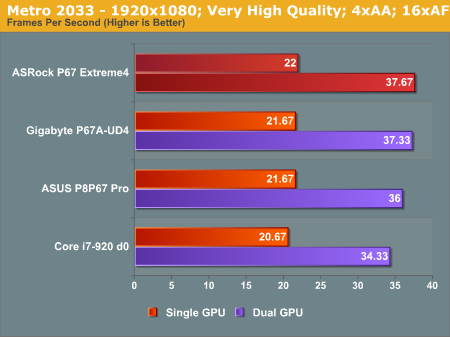Welcome to Sandy Bridge, with the ASRock P67 Extreme4
by Ian Cutress on January 3, 2011 7:00 AM EST- Posted in
- Motherboards
- ASRock
Dirt 2
Dirt 2 came to the PC in December 2009, developed by Codemasters with the EGO Engine. Resulting in favorable reviews, we use Dirt 2’s built-in benchmark under DirectX 11 to test the hardware. We test two different resolutions at two different quality settings, in single and dual GPU setups.


Metro 2033
Metro 2033 is the Crysis of the DirectX 11 world (at least until Crysis 2 is released), challenging every system that tries to run it at any high-end settings. Developed by 4A Games and released in March 2010, we use the built-in DirectX 11 benchmark to test the hardware.


Overview
Across the range of 3D benchmarks, there's not much to separate all of the boards, and even the Core i7-920 results. With so much processing power at hand, not much is needed in DirectX games without PhysX, even at 1920x1080 resolutions at very high quality. However, in single GPU mode, the ASRock board does score the best or near the best in all the benchmarks.










55 Comments
View All Comments
GTVic - Monday, January 3, 2011 - link
On page 3 there is a BIOS version listed?cmdrdredd - Monday, January 3, 2011 - link
no SATA 6Gbps, only two 8x PCIe lanes not two 16x, and it's generally low end.IanCutress - Wednesday, January 5, 2011 - link
The PCIe bandwidth for P67 is double that of P55/X58, so an 8x here is equivalent to an old 16x. A lot of people gloss over this fact, similar to wondering why the 6xxx cards have less SPs than 5xxx counterparts - it's an architectural change.Ian
drvelocity - Monday, January 3, 2011 - link
Why was the ASUS p8p67 getting spanked so hard in the single GPU tests? Any insight on that?Spivonious - Tuesday, January 4, 2011 - link
Please stop stating that mouse use is something new. I could use the mouse in the BIOS setup of my Tyan 440BX motherboard in 1998.Also, you state that you prefer two ethernet ports but never explain why. Unless you're using the computer as a gateway, why do you need more than one?
IanCutress - Wednesday, January 5, 2011 - link
We never state that using a mouse is something new. We state it's an improvement or a major benefit over the majority of previous BIOS implementations, especially in the last ten years of mainstream computing and to most consumers.In terms of dual Ethernet ports, there are many options:
1) Link Aggregation
2) Large format printers/plotters
3) Various file/server systems require a second NIC for metadata
It's true 99.99% of people won't need it, but for the low price of the chip, it's not too much to ask. Ideally, we'd want the Intel NIC every time - it's more configurable.
Ian
Spivonious - Wednesday, January 5, 2011 - link
"Major benefits include a graphical interface, the ability to use a mouse..."Maybe you didn't mean to, but it definitely implies that these things are new with UEFI.
1) Gigabit switches are under $30. The average broadband connection is well under 100Mbps. There is also very limited support for link aggregation in consumer-level products.
2) Yeah, let me pull that one out of the closet. Again, P67 is targeted at home users.
3) Can you name a few? And again, the average home user might have a simple file/media server.
I would be surprised if the next X series boards don't feature dual ethernet ports, but to mention it more than once on a board targeted towards the midrange is more than a bit silly.
IanCutress - Saturday, January 8, 2011 - link
P67 may be targeted at home users, but industry will look at it as well as a viable option, regardless of where it's targeted. It's easy to get roped into a home-users own little world when that's the only thing that maybe important to you. As a reviewer, it's important not to overlook that fact.The point we make is that it is easy enough for a manufacturer to increase the range of appeal of the hardware, by adding a small hardware element for which there is space. If you read through recent Anandtech motherboard reviews, there is a trend for industry level readers to take note of various products we review and add comments on the benefits/drawbacks certain products have for their line of industry, regardless of where the board is actually aimed for. This is why we cover things like dual Ethernet in reviews.
Ian
mapesdhs - Wednesday, January 5, 2011 - link
I could use a mouse for my SGI's equivalent setup in 1992. :D
Ian.
ibudic1 - Tuesday, January 4, 2011 - link
Thank you for posting your benchmark. We do 3D rendering, and some 3D computation (planned), and your benchmark makes sense for us.If I were to produce a benchmark for you to test would you be interested?